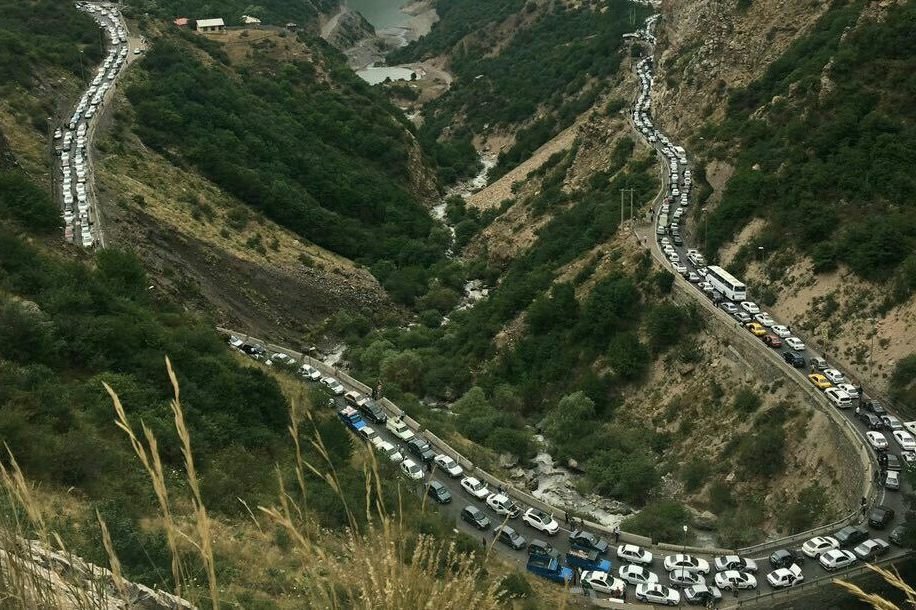Calm, quiet, pollution-free: These are the first words that spring to mind when describing the state of Tehran during the long weekend that ended on Friday.
More than anything, that is owed to the fact that a considerable number of Tehran’s residents had opted to travel to Shomal (Persian for north and referring to the northern parts of Iran) to spend the long-awaited three-day holiday.
This is not a staple fixture, as the two-day-long Eid al-Fitr holidays are based on a lunar calendar that may not be always followed by the weekend Friday holiday.
Of course, for most it was not much of a holiday, as many spent up to 24 hours traveling there and back, literally wasting a third of their vacation stuck in heavy traffic on the scenic Karaj-Chalous Road.
The curious thing about this is that it is not a one-off event; it is a typical occurrence when there are two consecutive days off.
Despite being fully aware of the very high chance of getting stuck in mind-numbingly long traffic congestions, people still choose to risk it and travel northward.
Vehicles were stationary for so long on Wednesday that dozens of people in the poorly-ventilated Kandovan Tunnel began to show symptoms of carbon monoxide poisoning and were treated at a makeshift roadside health clinic.
The accessibility (distance-wise, anyway) and affordability of northern cities has made Shomal a staple destination for a large segment of the sprawling capital’s residents. However, there is also a segment of society deterred from traveling by both economic and time constraints.
This and other reasons have compelled Iranian officials to come up with a plan to manage holidays and promote traveling.
Proponents and Opponents
Tourism officials and members of Tehran Chamber of Commerce, Industries, Mines and Agriculture have long sought to remedy the problem by urging the parliament to extend the country’s one-day weekend to two, but official pleas have been rejected 11 times over the past three years.
In fact, Iran is the only Muslim country that does not have a two-day weekend, with Friday being the official weekend and Thursday a half day.
Opponents of the scheme argue that by extending the weekends to two days, which is a standard across the world, including in Muslim countries, people’s productivity will decline and the economy will suffer loss of revenues.
However, supporters of the plan refute the claim, arguing that the world’s most developed countries have five working days and that by properly distributing holidays across the year, it is possible to boost domestic tourism and contribute to a growing economy.
Iran’s current weekend structure means the country’s business is out of touch with the world for almost four consecutive days (Thursday afternoon to Sunday evening).
Supporters of two-day weekends have proposed designating Friday and Saturday as weekend to address the problem.
To sweeten the pot for lawmakers that have been so quick to dismiss any bill pushing for a revised weekend structure, proponents of the scheme have suggested reducing Norouz holidays to a week, down from 14 days, which has been met with approval from netizens on social media.
Hungry for Vacation
As things stand, Iran’s longest holiday is the annual two-week Norouz Iranian New Year) holidays (March 20-April 1). This is while many western countries have a two-week Christmas holiday in December/January and a 14-day Easter holiday in April.
Even in most Muslim countries, the Eid al-Fitr holiday extends from five to 12 days, whereas in Iran it lasts for two days.
This long interval between holiday seasons leaves people, who work six days a week, hungry for vacation. So whenever there is a longer holiday, people decide to travel, only to be greeted by massive traffic congestions that are sure to spoil any attempts to seek rest and recuperation.
Mazandaran Province in the north, which stretches along the southern shores of the Caspian Sea, hosts the bulk of travelers on long weekends.
Home to 3.1 million people, Mazandaran had to cope with a massive influx of tourists these past three days, struggling to accommodate the whopping 3.1 million tourists that opted to travel there.
What this means is that—as almost half the people in Mazandaran live in rural areas—travelers in the province’s touristy cities such as Amol and Fereydounkenar outnumbered the locals by two to one.
By reducing working days to five and increasing weekends to two days, it is possible to spread travel across the year, preventing a pent-up demand for vacations that almost always strains the provincial infrastructure and triggers a sudden outpouring of tourists.
It also allows people to travel far and wide instead of going to the same place every time. Most Tehranis always choose to travel to Shomal, because it is the shortest destination with numerous tourism potentials they know very well.
Why would anyone spend a rare three-day weekend trying to find their way around a new place when they can travel to a location they can navigate in their sleep?
Furthermore, research shows that a well-rested workforce is more efficient and productive than a tired, dispirited one. Resting for two days at the end of a stressful working week can help people recharge their batteries and start the next week with energy and optimism—qualities that any employer would pay good money to see in their staff.



